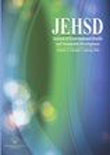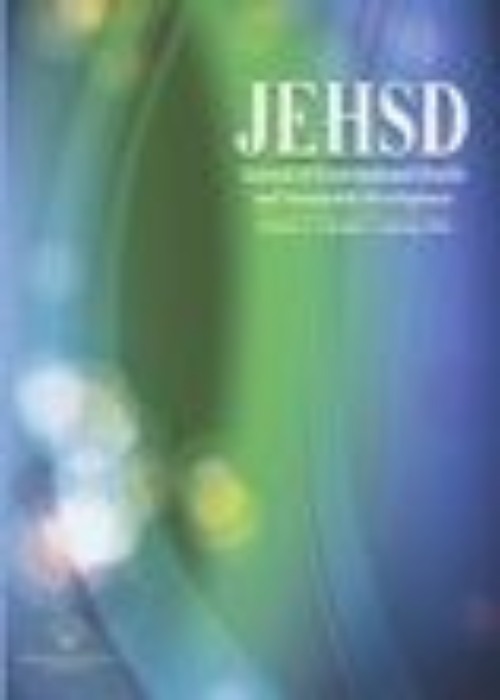فهرست مطالب

Journal of Environmental Health and Sustainable Development
Volume:2 Issue: 3, Sep 2017
- تاریخ انتشار: 1396/08/30
- تعداد عناوین: 8
-
Pages 326-332IntroductionMany vegetables are eaten raw which can lead to the prevalence of food borne diseases if not properly sanitized. The aim of this study was to compare the effect of chlorine, bleach and multioxidant solution in disinfection of edible vegetables.Materials And MethodsIn this experimental study, 100 g of vegetables (lettuce, basil and mint) was disinfected by sodium hypochlorite, chlorine, and multioxidant solution at a concentration of 200 mg/L in 5, 10,15 and 20 min. Microbial load analysis was performed using SPSS-20 software with paired t-tests and ANOVA.ResultsColiforms reduction in mixed vegetables using chlorine, sodium hypochlorite and electrochemical solution were 1.07-1.47, 0.67-1.39 and 2.17-2.47, respectively. For lettuce, coliforms were reduced to 0.77-1.47, 0.57-1.33 and 2.17-2.43 log/100g. After disinfection of mint using chlorine, sodium hypochlorite and electrochemical solution, coliforms were reduced to 1.07-2.17, 0.95-1.77 and 2.47 log/100g and after Basil disinfection, coliforms were reduced to 0.87-1.87, 0.83-1.39 and 2.47 log/100g, respectively.ConclusionWith increasing concentrations of disinfectants dose, inactivation of bacteria was done in less time. Electrochemical method is the suitable option to disinfect vegetables at home and emergencies.Keywords: Chlorine, Bleach, Multioxidant, Disinfection, Vegetables
-
Pages 333-339IntroductionSince some dyes and their metabolites have toxicity and carcinogenicity potential, and are dangerous to the health of different living creatures, discharge of untreated wastewaters containing large concentrations of dye compounds into water resources is one of the important environmental problems. Therefore, in this research, the efficiency of chemical coagulation process was investigated using ferric chloride coagulant to remove Direct Red 23 dye from colored wastewater.Materials And MethodsIn the experiments, a Jartest device was used and the effect of different parameters including the dose of the coagulant (20-200 mg/L), pH (3-10), and initial concentration of the dye (25-200 mg/L) on the efficiency of chemical coagulation process for removal of the dye was examined. Further, the final pH of the wastewater was investigated and the optimal conditions were determined.ResultsThe results indicated that the optimal dose of ferric chloride coagulant for Direct Red 23 dye removal of 97.7% is 40 mg/L at the optimal pH of 7. With increase in the dose of the coagulant, the dye removal efficiency increased, while the final pH of the wastewater decreased. Under constant conditions, with increase in the dye concentration, the dye removal efficiency diminished.ConclusionChemical coagulation by ferric chloride is a very effective and fast method for removal of direct dye from colored wastewater.Keywords: Dye, Removal, Coagulation
-
Pages 340-347IntroductionToday, bottled waters have attracted the assurance of consumers as one of the important drinking water supply resources, such that in some regions, the use of bottled waters has replaced the drinking water distribution system. The present study was carried out with the aim of measuring and determining the heavy metals in bottled water across a number of brands produced in Iran and comparing it with the drinking water standard.Materials And MethodsIn this descriptive-cross-sectional study, two different brands of bottled water were randomly sampled from the supermarket. To measure the heavy metals of interest, the samples were concentrated and then the concentration of some heavy metals such as copper, zinc, nickel, iron, aluminum, lead, and cadmium ions were measured by atomic absorption spectrophotometer. The mean concentration of ions was calculated in each brand and then compared with amount of standards.ResultsBrand No. 1, the concentration of zinc ion was larger in Brand 2 while in Brand No. 2 had larger copper, nickel, and aluminum ions. The results indicated that the concentration of the measured metal ions were below the allowable limit of drinking water standard across all of the studied samples.ConclusionBased on the obtained results from the investigated parameters, it can be concluded that the bottled water of both brands poses no health issue and is drinkable. Considering the changes in the concentration of ions and the increasing trend of consumption of bottled waters, their monitoring and qualitative control of pollutants are very crucial in terms of public health.Keywords: Heavy Metals, Bottled Water, Water Quality
-
Pages 348-356IntroductionBioremediation convertssoils pollutants to safe and non-toxic substance through metabolic activities of microorganisms. This research was conducted to evaluate the effect of bacteria on removal of phenanthrene and anthracene from polluted soils using chicken manure as an auxiliary substrate.Materials And MethodsFirst, uniformly-graded soils were transferred to the pilots, then activated sludge and chicken manure were added and mixed with the soilin specific ratios of 2:1 and 1: 1. Thereafter, phenanthrene and anthracene were manually added to the soil of each pilotat a rate of 12 mg/kg of soil. Anthracene and phenanthrene were measured using HPLC.ResultsThe results showed that in control pilots (without chicken manure and sludge), the removal percentage of pollutants (phenanthrene anthracene) was 15%. Nevertheless, when chicken manure and chicken manure sludge were used, the removal percentageincreased to 80 and 84%, respectively. Control pilots showed the lowest percentage of COD removal and varied from approximately 7 to 10%. Although the percentage of COD removal was approximately 80%, with the addition of chicken manure sludge, COD removal rate reached 90% (the highest removal percentage).ConclusionThe use of chicken manure as a cosubstratecanbe considered as an appropriate alternative for increasing the efficiency of bioremediation of oil compounds in soil.Keywords: Anthracene, Phenanthrene, Soil, Soil Pollutants
-
Pages 357-362IntroductionStandards of quality have been a huge success for organizations around the world. Hospitals need to establish standards, especially environmental ones. Hence, the codification of ISO 14001 is a necessity for hospitals. The aim of this study was to conduct a survey on the preparation of the teaching hospitals of the Shahid Beheshti University of Medical Sciences to implement ISO 14001.Materials And MethodsThis is a cross-sectional study based on a questionnaire with internal reliability (Cronbach's alpha = 0.787) to assess manager and staff attitudes toward the establishment of ISO 14001. The data was collected from hospitals at the Shahid Beheshti University of Medical Sciences. There were also questions on environmental standards. The guidelines for environment management system auditing were used to assess the general conditions. Then the data were analyzed by the SPSS software.ResultsThe mean age of the 250 people in the study was 32.52 ± 6.98 years with an age range of 21 to 55 years. Females made up 64.6% of the participants in this study and 35.4% were male. The relationship between the knowledge and the variables of work experience, education, age, and sex was performed, and the Analysis Of Variance (ANOVA) showed that the knowledge of the females was less than that of the males (p = 0.01). Based on the current situation with the standards, hospitals were classified.ConclusionThe application of quality management systems (e.g. ISO) can be due to the development of standards and the modification of health centers. Thus, they may promote the quality of services, reduce costs, and raise the level of public health.Keywords: ISO14001, Hospital, Environmental Management
-
Pages 363-370IntroductionHumic substances (HSs) are very complex and heterogeneous organic matter with high molecular weight and various functional groups, which are produced from the chemical and biological degradation of plants and animal tissues. HS can cause: colour, odour and taste problems in drinking water, biological growth in distribution systems, increase in chlorine demand for disinfection, membrane fouling and especially, formation of disinfection by-products (DBPs) after disinfection process. The aim of this study is to determine the effectiveness of XAD-7HP resin in the extraction of humic substances from raw water.Materials And MethodsIn the extraction of humic substances from water samples, amberlit anionic XAD-7HP resin with a strong cationic resin AG MP50 was used, while for the determination of humic acid, a High Performance Liquid Chromatography (HPLC) system equipped to BIO SUIT SEC columns was used.ResultsThe average extraction efficiency for XAD-7HP was 77% and HA concentration determined in all seasons ranges from 0.15 to 0.29 mg/L in raw water.ConclusionsFrom the findings of this study, it can be concluded that the use of XAD-7HP is a proper and effective method for the extraction of HS and its extraction efficiency is more influenced by pH and turbidity than other parameters. It can also be deduced from this study that XAD-7HP resin was most efficient at a pH of 2 and an increase in turbidity resulted in a corresponding decrease in the efficiency of resin.Keywords: Humic Substances, XAD-7HP, Raw Water


